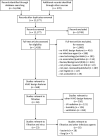The impact of heating, ventilation, and air conditioning design features on the transmission of viruses, including the 2019 novel coronavirus: A systematic review of filtration
- PMID: 37725631
- PMCID: PMC10508630
- DOI: 10.1371/journal.pgph.0002389
The impact of heating, ventilation, and air conditioning design features on the transmission of viruses, including the 2019 novel coronavirus: A systematic review of filtration
Abstract
Historically, viruses have demonstrated airborne transmission. Emerging evidence suggests the novel coronavirus (SARS-CoV-2) that causes COVID-19 also spreads by airborne transmission. This is more likely in indoor environments, particularly with poor ventilation. In the context of airborne transmission, a vital mitigation strategy for the built environment is heating, ventilation, and air conditioning (HVAC) systems. HVAC features could modify virus transmission potential. A systematic review was conducted to identify and synthesize research examining the effectiveness of filters within HVAC systems in reducing virus transmission. A comprehensive search of OVID MEDLINE, Compendex, and Web of Science Core was conducted to January 2021. Two authors were involved in study selection, data extraction, and risk of bias assessments. Study characteristics and results were displayed in evidence tables and findings were synthesized narratively. Twenty-three relevant studies showed that: filtration was associated with decreased transmission; filters removed viruses from the air; increasing filter efficiency (efficiency of particle removal) was associated with decreased transmission, decreased infection risk, and increased viral filtration efficiency (efficiency of virus removal); increasing filter efficiency above MERV 13 was associated with limited benefit in further reduction of virus concentration and infection risk; and filters with the same efficiency rating from different companies showed variable performance. Adapting HVAC systems to mitigate virus transmission requires a multi-factorial approach and filtration is one factor offering demonstrated potential for decreased transmission. For filtration to be effective, proper installation is required. Of note, similarly rated filters from different companies may offer different virus reduction results. While increasing filtration efficiency (i.e., increasing MERV rating or moving from MERV to HEPA) is associated with virus mitigation, there are diminishing returns for filters rated MERV 13 or higher. Although costs increase with filtration efficiency, they are lower than the cost of ventilation options with the equivalent reduction in transmission. Systematic review registration: PROSPERO 2020 CRD42020193968.
Copyright: © 2023 Thornton et al. This is an open access article distributed under the terms of the Creative Commons Attribution License, which permits unrestricted use, distribution, and reproduction in any medium, provided the original author and source are credited.
Conflict of interest statement
The authors have declared that no competing interests exist.
Figures
Similar articles
-
The impact of heating, ventilation, and air conditioning design features on the transmission of viruses, including the 2019 novel coronavirus: A systematic review of ultraviolet radiation.PLoS One. 2022 Apr 8;17(4):e0266487. doi: 10.1371/journal.pone.0266487. eCollection 2022. PLoS One. 2022. PMID: 35395010 Free PMC article.
-
The Impact of Heating, Ventilation, and Air-Conditioning Design Features on the Transmission of Viruses, Including SARS-CoV-2: Overview of Reviews.Interact J Med Res. 2022 Dec 23;11(2):e37232. doi: 10.2196/37232. Interact J Med Res. 2022. PMID: 36343208 Free PMC article. Review.
-
The impact of heating, ventilation, and air conditioning design features on the transmission of viruses, including the 2019 novel coronavirus: A systematic review of ventilation and coronavirus.PLOS Glob Public Health. 2022 Jul 5;2(7):e0000552. doi: 10.1371/journal.pgph.0000552. eCollection 2022. PLOS Glob Public Health. 2022. PMID: 36962357 Free PMC article.
-
Air cleaning technologies: an evidence-based analysis.Ont Health Technol Assess Ser. 2005;5(17):1-52. Epub 2005 Nov 1. Ont Health Technol Assess Ser. 2005. PMID: 23074468 Free PMC article.
-
A systematic review and meta-analysis of indoor bioaerosols in hospitals: The influence of heating, ventilation, and air conditioning.PLoS One. 2021 Dec 23;16(12):e0259996. doi: 10.1371/journal.pone.0259996. eCollection 2021. PLoS One. 2021. PMID: 34941879 Free PMC article.
Cited by
-
Virology-The next fifty years.Cell. 2024 Sep 19;187(19):5128-5145. doi: 10.1016/j.cell.2024.07.025. Cell. 2024. PMID: 39303682
References
-
- World Health Organization (WHO). WHO Director-General’s opening remarks at the media briefing on COVID-19–11 March 2020. https://www.who.int/director-general/speeches/detail/who-director-genera.... Accessed 4 April 2021.
-
- ASHRAE. ASHRAE epidemic task force releases updated airborne transmission guidance. 5 April 2021. American Society of Heating, Refrigerating, and Air-Conditioning Engineers (ASHRAE). https://www.ashrae.org/about/news/2021/ashrae-epidemic-task-force-releas.... Accessed April 22, 2021.
LinkOut - more resources
Full Text Sources
Miscellaneous

